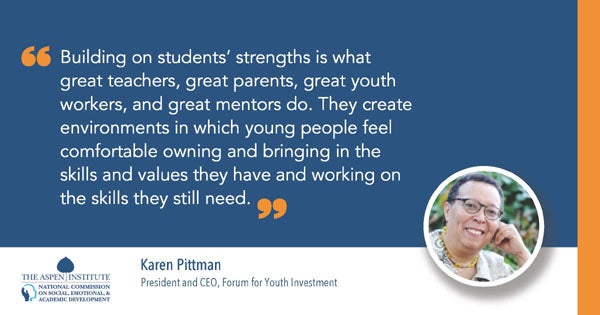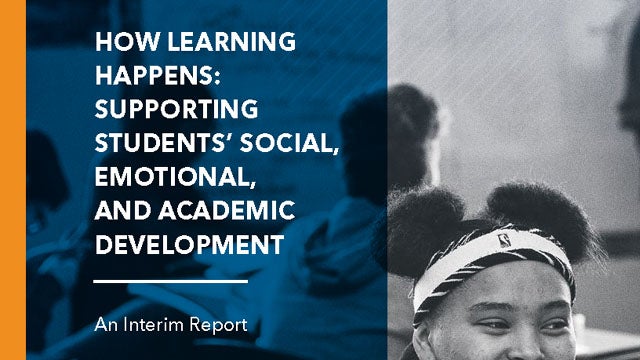As a result of listening to those engaged in this work and visiting local communities that have made students’ social, emotional, and academic development a priority, the Commission has learned the following:
- Learning is social and emotional. Decades of research in human development, cognitive and behavioral neuroscience, and educational practice and policy have illuminated that major domains of human development—social, emotional, cognitive, linguistic, academic—are deeply intertwined in the brain and in behavior. Moreover, all are central to learning and success.
- Supporting students’ social and emotional development encompasses a range of instructional approaches that must be implemented intentionally. Multiple instructional strategies can be used to support students’ social and emotional development, including specific programs, integration into classroom lessons, and opportunities such as project-based learning and internships that require students to practice these skills. The common factor is that all approaches should be implemented intentionally and that students should have opportunities to explicitly learn about and apply social and emotional skills.
- The interconnectedness of social, emotional, and academic development must be reflected in all aspects of schooling. That means from classroom instruction, to a school’s culture and climate, to family engagement. Efforts to approach these developmental domains from a lens of integration that encompasses the entire school community are likely to be the most effective and sustainable and are less likely to be considered an add-on or nice-to-have.
- Effective social and emotional development creates learning environments that support each student’s individual needs. To facilitate student success, adults must understand the broader environmental and social context in which students learn. They must also create and assess learning conditions that give students the opportunity to activate, demonstrate, and grow the social, emotional, and academic competencies they bring to the classroom. Our students’ diversity of cultural backgrounds and identities means that our approaches to social, emotional, and academic development must affirm their culture, background, and experiences.

- Educators’ social and emotional competence is crucial to this work. Teacher preparation and ongoing professional development must address the science behind how students learn and develop, and provide opportunities for educators to practice this work and observe and coach their peers. And teachers and school leaders must be given opportunities to build their own social and emotional skills so that they can, in turn, model and support these skills in their students.
- Local communities need to shape and drive the process of comprehensively supporting students. There’s no single, one-size-fits-all approach to social, emotional, and academic development. To do this work well, local leaders— including educators working shoulder-to-shoulder with families, civic leaders, and out-of-school-time providers—need resources, guidance, and a supportive policy environment. They also need the autonomy and flexibility to determine their approach based on their students’ unique strengths, needs, and contexts.


